
Barcelona
Province - Cardona |
|

| Cardona is a town ìn
Catalonia, Spain, in the province of Barcelona; about 90 km northwest of
the city of Barcelona, on a hill almost surrounded by the river Cardoner,
a branch of the Llobregat.
Cardona is a picturesque town, with
a citadel named the Castle of Cardona set high on a hill, and the 14th-century
Romanesque Church of St. Vincenç. It is celebrated for the extensive
deposit of rock salt in its vicinity. The salt forms a mountain mass (called
Muntanya de Sal) covered by a thick bed of a reddish-brown clay, and apparently
resting on a yellowish-grey sandstone. It is generally more or less translucent,
and large masses of it are quite transparent. The hill has been worked
like a mine since Roman times; pieces cut from it have been carved by artists
in Cardona into images, crucifixes and many articles of an ornamental kind. |

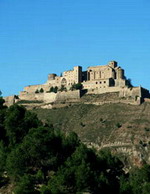 |
Parador
de Cardona - Barcelona Province
Mediaeval Castle with Tower
and Romanesque Church. The Hotel is located on a headland in a 9th century
fortified enclosure, alongside the 11th century Minyona tower and an 11th
century church with characteristic features from the surrounding Catalan
Romanesque. Its location provides exceptional panoramic views over the
city and the fertile lands bathed by the River Cardoner. Some of
the hotel rooms have charming canopy beds. Pits, towers, walls and gothic
features come together with a predominantly comfortable décor and
Catalan-inspired mediaeval furnishings. Catalan cuisine is served
in the dining room including aubergine terrine with pig’s trotters, selections
of sausages and especially barbecue dishes with the braised lamb shoulder
a highlight. |

Barcelona
- Vic |
|

| Vic is the capital of the
comarca of Osona, in the province of Barcelona, Catalonia, Spain. Vic's
location, only 69 km far from Barcelona and 60 km from Girona, has made
it one of the most important towns in central Catalonia. |

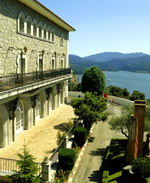 |
Parador
de Vic-Sau, Vic, Barcelona Province
A Masía with Views
- The hotel is in one of the most beautiful natural settings in the Osona
area, with the Guillerías mountains in the background and the Sau
reservoir at its feet. The peaceful scenery is ideal for outdoor
and adventure sports and for visiting very old Romanesque churches. This
is the closest Parador to Barcelona (82 km. by motorway). With the Parador
just a step away, one can visit this cosmopolitan city and return every
day. The Parador reflects the traditional style of the Catalan masía
or country house, with its well-tended garden, rooms with terrace and a
magnificent swimming pool with exceptional views, and spacious, comfortable
lounges. The best of Catalan cooking - In the restaurant you can sample
the traditional gastronomy of the Osona region. |

Tarragona
- Tortosa |
|

| Tortosa is the capital of
the comarca of Baix Ebre, in the province of Tarragona, in Catalonia, Spain,
located at 12 metres above the sea, by the Ebre river. Population 34,832
(2007). After more than four hundred years of Muslim Arabic rule,
the city was conquered by the Count Ramon Berenguer IV of Barcelona in
1148. |

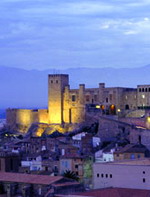 |
Parador
de Tortosa, Tortos, Tarragona Province
In the centre of the fertile
Ebro valley and sheltered by the Beceite mountains, which provide a stunning
view from the pool and balconies, the Hotel stands in the higher part of
this town which adds its own beauty to the attractions of the different
types of natural settings around it. Abderramán III decided
to build the fortress which now houses La Zuda (well), and four splendid
Catalan Gothic windows. The interior decor of the hotel reflects a predominantly
Christian, baronial style, with traditional furniture and wooden beams.
Within the arabesque-decorated walls the dining room stands out with its
Gothic windows. Sit by one of the Gothic windows in the Parador’s dining
room and enjoy its rice dishes, its anguila en suc, its suquet de peix
(fish stew) or the local pastries, pastissets and garrofetas. |

Girona
- Begur |
|

| Begur is a city in the province
of Girona (Gerona), Spain. It is located in the Catalan comarca of Baix
Empordà. Begur has 3,986 inhabitants (according to the census
of 2005). It is an important tourist attraction in the Baix Empordà.
During the summer, the population can exceed 40,000 people.
Despite of its touristic character,
the village has an important historical remnants that go back in early
history. The castle of Begur is a good example of medieval remains. The
castle was constructed in the 16th and 17th century. The town of
Begur also includes Esclanyà (with a Roman town centre), Aiguafreda,
Sa Riera, Sa Tuna, Aiguablava and Fornells. Some of the most prestigious
beaches of the Costa Brava can be found here: Sa Riera, Aiguafreda, sa
Tuna, Platja Fonda, Fornells and Aiguablava. The latter is also home to
a Parador Hotel. |

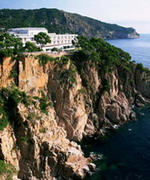 |
Parador
de Aiguablava, Begur, Girona Province
The Parador de Aiguablava
is situated in the unique Punta D'es Muts enclave, surrounded by pine trees
and overlooking the sea. Here guests can enjoy beautiful beaches, coves
and unspoilt landscapes. It is an ideal location for sports and outdoor
activities, as well as relaxing walks through picturesque green settings.
Under the distinctive light of the Mediterranean, the hotel provides its
guests with a high level of comfort and a range of services both for individual
guests and business conferences. There is a gym, swimming pool and sauna,
as well as rooms with spectacular views overlooking the sea. Coastal
influence is also reflected in the ‘ampurdanesa’ cuisine, whose typical
dishes include sea urchins, baked snails and chicken and lobster stew.
During the summer, dishes can be sampled on the beach alongside the restaurant.
The Parador has its own restaurant, ‘Mar i Vent’ which is separate from
the hotel located in the neighbouring cove overlooking the Mediterranean
Sea. |

| Pyrenees
- Arties - Lleida Province |
|
 
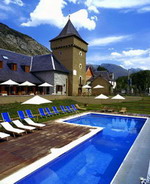 |
Parador
de Artíes, Arties, Lleida Province
Located in the 'Val dArán',
just 7 km from Baqueira, in an area of the Catalan Pyrenees where the woods,
the snow-capped peaks in winter and the freshness of the green in summer
are the true protagonists of the landscape. The Parador, in the style of
the local architecture, rises up in the so-called House of D. Gaspar de
Portolá, the discoverer of California. It has attic bedrooms, wood-lined
beams and numerous conference rooms, among which the Salón Chimenea
stands out. The friendly common rooms invite you to stay the night in an
ideal setting for taking up outdoor activities. The cooking is influenced
by the specialties of the region such as 'olla aranesa' (stew), trout 'a
la llosa', 'civet de jabalí' (jugged wild boar) and the sweet 'pescajus
de Artíes'. |

Pyrenees
- La Seu D'Urgell - Lleida Province |
|

| La Seu d'Urgell (formerly
Urgell) is a town located in the Catalan Pyrenees, is the capital of the
comarca Alt Urgell, head of the judicial district of la Seu d'Urgell and
the seat of Bishop of Urgell, one of the Andorra co-princes. It is in the
functional area of Alt Pirineu i Aran (High Pyrenees and Aran), is the
town with more inhabitants, concentrating the 17'4%. With Puigcerdà
concentrate the thirty percent of the population of the area.
It is located in the confluence between
the river Segre and Valira. The city is in the local region of Urgellet,
a Pyrenean region formed by 16 municipalities of Alt Urgell. Urgellet and
Andorra were the originary County of Urgell with capital in la Seu d'Urgell
before the county expansion to the south.
Alt Urgell is the gateway to the
state of Andorra and the proximity to this important population center
and economic activity is largely one of the reasons for the current drive
of the city of la Seu d'Urgell within Alt Pirineu i Aran.
The town's patron saints are Sant
Ot d'Urgell, Sant Sebastià and the Virgin of Urgell. While the Virgin
of Núria and Sant Ermengol are the main patrons of the diocese of
Urgell. Sant Ermengol is the most prominent in the city than other patrons.
Probably that's why there are various events throughout the year dedicated
to Sant Ermengol, as the Sant Ermengol Fair, one of the oldest in Catalonia,
and the altarpiece of Sant Ermengol.
The Parc Olímpic del Segre,
built in 1992 for the Barcelona Summer Olympic Games, is a pump-driven
canoe and kayak sports venue located adjacent to the historical centre
of la Seu d'Urgell. |

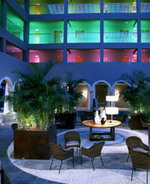 |
Parador
de La Seu D'Urgell, Lleida Province
Alongside the Romanesque
cathedral of La Seu d'Urgell towers the Hotel, in a monumental and natural
setting which attracts numerous hikers, mountain lovers and an infinity
of tourists who take a step closer to Andorran heaven. The world-famous
Parc Olímpic del Segre Canoeing Championships are held here in the
summer. Of note in the interior are the ancient Renaissance cloister
and a pleasant covered swimming pool. Seventy-nine rooms, a covered
pool, sauna, solarium, coffee shop, air conditioning in all rooms... make
this Parador a tempting offer of accommodation from which to explore the
most beautiful and attractive areas of the Catalan Pyrenees. 'Alt
Urgell', the Parador´s restaurant, can be accessed directly from
the street or from the Parador itself. Here, both registered and non-registered
guests can savor the delights and flavors of the Lérida region. |

Pyrenees
- Vielha - Lleida Province |
|

| Vielha e Mijaran is a municipality
in the comarca of the Val d'Aran in Catalonia, Spain. It was created in
1970 by the merger of the municipalities of Arròs e Vila, Betlan,
Escunhau, Gausac, Vielha and Vilac: the former municipalities retain some
privileges as "decentralised municipal entities" (entitats municipals descentralitzades,
EMD), as does the village of Betren. Mijaran literally means "Middle Valley"
in Aranese, as the habited part of the municipality is situated in the
valley of the Garonne (Garona). The Noguera Ribagorçana has its
source on the territory of the municipality, on the opposite side of the
watershed. The ajuntament (town hall) is in Vielha, which is also the capital
of the comarca.
The municipality is linked to France
and to the rest of Catalonia (via the Vielha tunnel) by the N-230 road.
The C-28 (old name: C-142) road continues up the valley to Naut Aran, and
on over the Bonaigua pass (2072 m) to the comarca of Pallars Sobirà.
This road, the higher stretches of which are impassable in winter, was
the only route between the Val d'Aran and the rest of Spain before the
opening of the Vielha tunnel in 1948. |

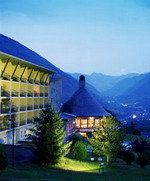 |
Parador
de Vielha, Vielha - Lleida Province (Pyrenees)
The hotel is in an area
of unparalleled beauty, the Arán valley, of green and white landscapes
beneath the radiant light of the Pyrenees of Lleida. Ideal for skiers,
ramblers and nature-lovers, the hotel’s rooms offer unbeatable views of
the mountains, even more spectacular from the circular glazed restaurant.
Many of the hotel’s bedrooms have views of the valley and terrace.
Come to the Parador de Vielha for an unforgettable experience. Let the
beauties of the Arán valley bewitch you, and relax in the Spa of
the Parador. Try the services of the Vielha Spa. We recommend satisfying
your hearty mountain appetite with traditional Pyrenean dishes such as
civet of wild boar, pescajus pancakes with cream or the delicious local
stew, olla aranesa. |
Top
|

